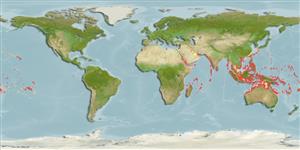Common names from other countries
Environment: milieu / climate zone / depth range / distribution range
Ecologia
marinhas associadas(os) a recifes; não migratória (Ref. 51243); intervalo de profundidade 5 - 110 m (Ref. 128797). Tropical; 32°N - 24°S, 30°E - 137°W
Indo-Pacific: Red Sea, East Africa eastward through northern Australia to Line, Marquesas and Society Islands, north to southern Japan
Tamanho / Peso / Idade
Maturity: Lm ? range ? - ? cm
Max length : 50.0 cm TL macho/indeterminado; (Ref. 4420); common length : 30.0 cm TL macho/indeterminado; (Ref. 3109)
Descrição breve
Chaves de identificação | Morfologia | Morfometria
Espinhos dorsais (total) : 3; Raios dorsais moles (total) : 33 - 36; Espinhos anais: 0; Raios anais moles: 28 - 31.
Inhabits reef channels or along slopes that are subject to strong currents (Ref. 48637). Occur in current-swept seaward coral reefs. Usually form aggregations and feed on zooplankton as well as sponges (Ref. 9770). Juveniles associated with isolated patches of rubble or crevices with proper-sized shelter holes (Ref. 1602). Oviparous (Ref. 205). Form large schools to feed on zooplankton (Ref. 48637). Also taken by drive-in nets (Ref. 9770). Marketed fresh or dried-salted. Minimum depth reported taken from Ref. 30874. Popular aquarium fish (Ref. 37816).
Life cycle and mating behavior
Maturities | Reprodução | Spawnings | Egg(s) | Fecundities | Larvas
Distinct pairing (Ref. 205). Only females tend the eggs but both parents keep guard (Ref. 116451).
Randall, J.E., G.R. Allen and R.C. Steene, 1990. Fishes of the Great Barrier Reef and Coral Sea. University of Hawaii Press, Honolulu, Hawaii. 506 p. (Ref. 2334)
Categoria na Lista Vermelha da IUCN (Ref. 130435)
CITES (Ref. 128078)
Not Evaluated
Ameaça para o homem
Harmless
Utilização humana
Pescarias: pouco comercial; Aquário: Espécies comerciais
Ferramentas
Relatórios especiais
Descarregue XML
Fontes da internet
Estimates based on models
Preferred temperature (Ref.
115969): 24.9 - 29.1, mean 27.9 (based on 918 cells).
Phylogenetic diversity index (Ref.
82804): PD
50 = 1.0000 [Uniqueness, from 0.5 = low to 2.0 = high].
Bayesian length-weight: a=0.03236 (0.01900 - 0.05512), b=2.96 (2.81 - 3.11), in cm Total Length, based on LWR estimates for this species & (Sub)family-body (Ref.
93245).
Nível Trófico (Ref.
69278): 3.4 ±0.41 se; based on food items.
Resiliência (Ref.
120179): Médio, tempo mínimo de duplicação da população 1,4 - 4,4 anos (Preliminary K or Fecundity.).
Fishing Vulnerability (Ref.
59153): Moderate vulnerability (40 of 100).
